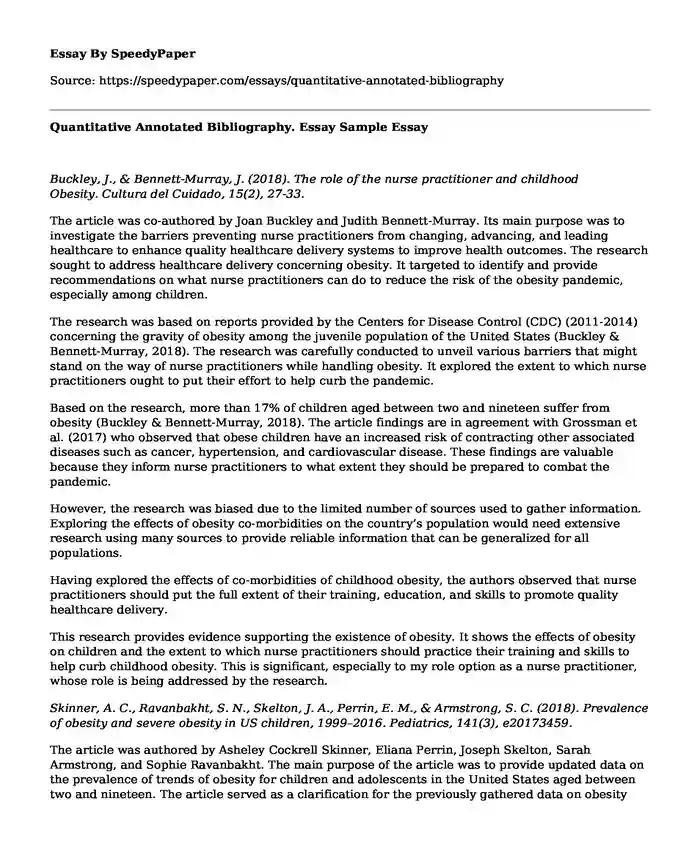
| Type of paper: | Essay |
| Categories: | Healthcare Diet Nutrition Literature review |
| Pages: | 4 |
| Wordcount: | 852 words |
Buckley, J., & Bennett-Murray, J. (2018). The role of the nurse practitioner and childhood Obesity. Cultura del Cuidado, 15(2), 27-33.
The article was co-authored by Joan Buckley and Judith Bennett-Murray. Its main purpose was to investigate the barriers preventing nurse practitioners from changing, advancing, and leading healthcare to enhance quality healthcare delivery systems to improve health outcomes. The research sought to address healthcare delivery concerning obesity. It targeted to identify and provide recommendations on what nurse practitioners can do to reduce the risk of the obesity pandemic, especially among children.
The research was based on reports provided by the Centers for Disease Control (CDC) (2011-2014) concerning the gravity of obesity among the juvenile population of the United States (Buckley & Bennett-Murray, 2018). The research was carefully conducted to unveil various barriers that might stand on the way of nurse practitioners while handling obesity. It explored the extent to which nurse practitioners ought to put their effort to help curb the pandemic.
Based on the research, more than 17% of children aged between two and nineteen suffer from obesity (Buckley & Bennett-Murray, 2018). The article findings are in agreement with Grossman et al. (2017) who observed that obese children have an increased risk of contracting other associated diseases such as cancer, hypertension, and cardiovascular disease. These findings are valuable because they inform nurse practitioners to what extent they should be prepared to combat the pandemic.
However, the research was biased due to the limited number of sources used to gather information. Exploring the effects of obesity co-morbidities on the country’s population would need extensive research using many sources to provide reliable information that can be generalized for all populations.
Having explored the effects of co-morbidities of childhood obesity, the authors observed that nurse practitioners should put the full extent of their training, education, and skills to promote quality healthcare delivery.
This research provides evidence supporting the existence of obesity. It shows the effects of obesity on children and the extent to which nurse practitioners should practice their training and skills to help curb childhood obesity. This is significant, especially to my role option as a nurse practitioner, whose role is being addressed by the research.
Skinner, A. C., Ravanbakht, S. N., Skelton, J. A., Perrin, E. M., & Armstrong, S. C. (2018). Prevalence of obesity and severe obesity in US children, 1999–2016. Pediatrics, 141(3), e20173459.
The article was authored by Asheley Cockrell Skinner, Eliana Perrin, Joseph Skelton, Sarah Armstrong, and Sophie Ravanbakht. The main purpose of the article was to provide updated data on the prevalence of trends of obesity for children and adolescents in the United States aged between two and nineteen. The article served as a clarification for the previously gathered data on obesity trends among children in the United States.
The researchers used data collected and compiled by the National Health and Nutrition Examination Survey (NHUNES) for years between 1999 and 2016 (Skinner et al., 2018). The researchers used data on physical weights and heights provided by NHANES to compute individual BMI. They reported an estimated prevalence of obesity and overweight by two-year cycles. The cycles were then compared by the use of adjusted Wald tests (Skinner et al., 2018). On the other hand, linear trends were determined by least squares regression.
The study found a positive linear trend of obesity and overweight among children aged between two and nineteen. Those aged between two and five years showed a remarkably higher increase in obesity in the years 2015 and 2016 than the other cycles. The research was significant because it provided an up-to-date trend of obesity prevalence in children.
The shortcoming of this research was that it did not report the causes of obesity among different cycles in the trend. There was also no geographical analysis of the trends provided, making it challenging to identify the possible factors leading to increased obesity in those areas.
The authors refute the previous reports that claimed the rate of obesity was rapidly decreasing. Instead, they report a rapidly increasing rate of obesity among children aged two to nineteen countrywide.
The article is very significant because it provides a piece of solid evidence on the existence of obesity and overweight cases among American children. The article also reports a rapidly increasing trend of obesity among children, which is in agreement with the findings by Grossman et al. (2017). Therefore, it serves as a motivation for nurse practitioners to find creative ways based on training and education to help curb the problem. As a nurse practitioner, this article is of great importance and is worth studying for valuable insight to curb childhood obesity.
References
Buckley, J., & Bennett-Murray, J. (2018). The role of the nurse practitioner and childhood Obesity. Cultura del Cuidado, 15(2), 27-33. https://revistas.unilibre.edu.co/index.php/cultura/article/view/5110Grossman, D. C., Bibbins-Domingo, K., Curry, S. J., Barry, M. J., Davidson, K. W., Doubeni, C. A., ... & Landefeld, C. S. (2017). Screening for obesity in children and adolescents: US Preventive Services Task Force recommendation statement. Jama, 317(23), 2417-2426. https://jamanetwork.com/journals/jama/article-abstract/2632511Skinner, A. C., Ravanbakht, S. N., Skelton, J. A., Perrin, E. M., & Armstrong, S. C. (2018). Prevalence of obesity and severe obesity in US children, 1999–2016. Pediatrics, 141(3), e20173459. https://pediatrics.aappublications.org/content/141/3/e20173459.full
Cite this page
Quantitative Annotated Bibliography. Essay Sample. (2023, Aug 23). Retrieved from https://speedypaper.net/essays/quantitative-annotated-bibliography
Request Removal
If you are the original author of this essay and no longer wish to have it published on the SpeedyPaper website, please click below to request its removal:
- Free Essay with the Research on Mental Disorders in Children Living in Urban Areas
- Obesity Essay Example from Our Database
- Grendel's Mother - Book Review Essay Example
- Short Gothic Story Free example
- Essay Example on Wellness in Society
- Essay Example. Rural Georgia Community
- Free Essay Sample - Odyssey Epic Hero Characteristics
Popular categories




